What to Do with Green Tomatoes Before Frost
This post may contain affiliate links, which means that I may receive a commission if you make a purchase using these links. As an Amazon Associate I earn from qualifying purchases.
Not sure what to do with green tomatoes still on the vine as the season ends? Learn ways to take advantage of these unripe tomatoes by ripening them indoors, incorporating them into tasty recipes, or preserving them for future use.

As the gardening season draws to a close, you may find yourself with a bounty of healthy unripe tomatoes still hanging on the vine. When the threat of first frost looms, it can be disheartening to think that all those green tomatoes might go to waste. Fortunately, there are several ways to make the most of these gems—whether it’s using them in delicious recipes, ripening them indoors, or preserving them for later.
This guide will walk you through how to handle unripe tomatoes when frost threatens your harvest. From easy green tomato recipes, indoor ripening techniques, and preservation methods such as freezing, dehydrating, and canning, you’ll find plenty of options to enjoy your green tomatoes long after the growing season ends.
What Are Green Tomatoes?
For the purposes of this article, green tomatoes refer to unripe tomatoes that haven’t yet reached their full color. These are not to be confused with varieties of tomatoes that are naturally green when ripe, such as Aunt Ruby’s German Green, Green Zebra, or Evergreen, which are green by design and have a different flavor profile.
Additionally, green tomatoes are different from tomatillos, a tangy fruit often used in Mexican cooking. Tomatillos have a papery husk and a more tart flavor, while green tomatoes are firmer and more subtle in taste.
How Do Green Tomatoes Taste?
Green tomatoes have a distinctly firm texture and a tart, slightly acidic flavor compared to fully ripened tomatoes. Their crispness and tang make them perfect for recipes that call for a bit of bite, such as frying, pickling, or incorporating into sauces. They’re less sweet than ripe tomatoes, which means they work well in savory dishes where a more neutral or sour flavor is preferred.
Whether you’re preserving them for later or using them fresh, green tomatoes bring a unique flavor to the table that’s worth exploring.
How to Use Green Tomatoes
Green tomatoes are incredibly versatile in the kitchen. Here are some popular ways to use freshly harvested green tomatoes:
- Fried Green Tomatoes: A Southern classic, these tomatoes are breaded and fried for a crispy, tangy side dish or appetizer. Try our recipe: Fried Green Tomatoes.
- Fresh Green Tomato Salsa: Their tart flavor makes green tomatoes an excellent base for salsa, providing a fresh, zesty taste. Simply replace the red tomatoes with green in this Garden Fresh Salsa recipe.
- Pickled Green Tomatoes: Perfect for preserving, pickled green tomatoes add a crunchy, flavorful bite to sandwiches or salads. Try this Refrigerator Pickles recipe.
- Green Tomato Salsa Verde: Roasting enhances the natural acidity of tomatoes, making them perfect for salsa verde. Use green tomatoes in place of tomatillos in this Roasted Salsa Verde recipe.
How to Ripen Green Tomatoes Indoors
If frost is approaching and your tomatoes haven’t ripened on the vine, you can still save your crop by ripening the green tomatoes indoors. With the right techniques, you’ll have fresh, home-grown tomatoes even after frost. Here’s a detailed step-by-step guide to help you ripen green tomatoes indoors:
Choose Mature Green Tomatoes
Not all green tomatoes will ripen off the vine, so it’s important to pick the right ones. Look for full-sized tomatoes that have started to lighten from dark green to a gray-green or yellowish-green hue. Mature tomatoes showing signs of ripening are more likely to ripen indoors fully. Avoid tomatoes that are bruised, damaged, or show any signs of disease, as these will likely rot rather than ripen.
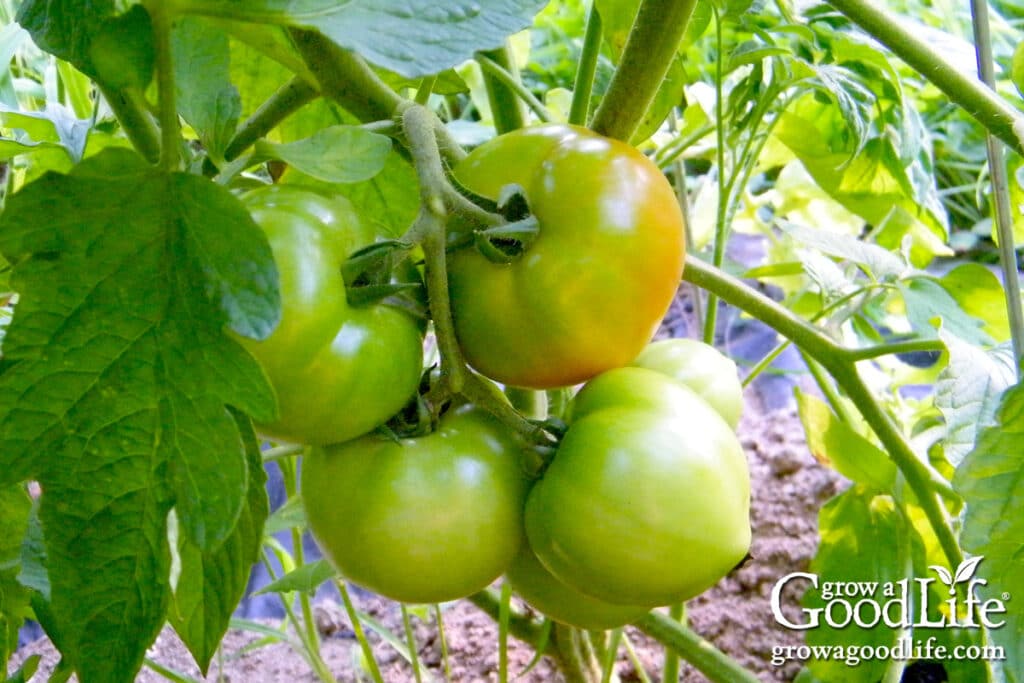
Immature green tomatoes (those that are small and deep green) may not ripen successfully and could shrivel instead. However, using the methods described later in this post, you can still preserve these in other ways, such as freezing, dehydrating, or canning.
Once you’ve harvested your tomatoes, sort them by ripeness. Group together those already blushing (starting to turn color), as they’ll ripen faster, and set aside the fully green ones, which will take longer.
Ripening on a Counter or Windowsill
For tomatoes that are already starting to turn red, the easiest method is to place them on a sunny windowsill or countertop. Spread them out in a single layer to avoid bruising, and turn them occasionally to ensure even ripening. You’ll have fully ripe tomatoes ready to enjoy within a few days.

Ripening Fully Green Tomatoes
Green tomatoes with no signs of ripening will need a bit more time and care. To prevent rot while they ripen, it’s helpful to use a disinfecting solution to slow the growth of bacteria or mold. Here’s how to prepare your tomatoes for storage:
- Mix one teaspoon of liquid bleach with one quart of water.
- Rinse the tomatoes under cool running water to remove any dirt or debris.
- Dip each tomato in the bleach solution to sanitize the surface.
- Drain and allow the tomatoes to air dry completely before storing them.
Once sanitized, you can use one of the following methods to encourage ripening:
- Paper Bag Method: If you have only a few tomatoes, place them in a paper bag with a ripe banana or apple. These fruits release ethylene gas, a natural ripening agent. Fold the top of the bag closed, but leave some air circulation to prevent moisture buildup. Check your tomatoes daily for ripeness and remove any that have fully ripened to avoid overripening.
- Cardboard Box Method: Use a shallow cardboard box for a larger amount of green tomatoes. Line the box with paper towels or newspaper, then place your tomatoes in a single layer. Add a banana or apple to help speed up the ripening process by releasing ethylene gas. Cover the tomatoes with another layer of newspaper or a towel, but make sure air can still circulate.
Store the bag or box in an area between 55 to 70°F. At temperatures between 65 to 70°F, your green tomatoes will ripen in about two weeks. If stored at around 55°F, ripening will take longer, typically 3 to 4 weeks. Avoid temperatures below 50°F, as this can cause the tomatoes to develop a bland, off flavor.
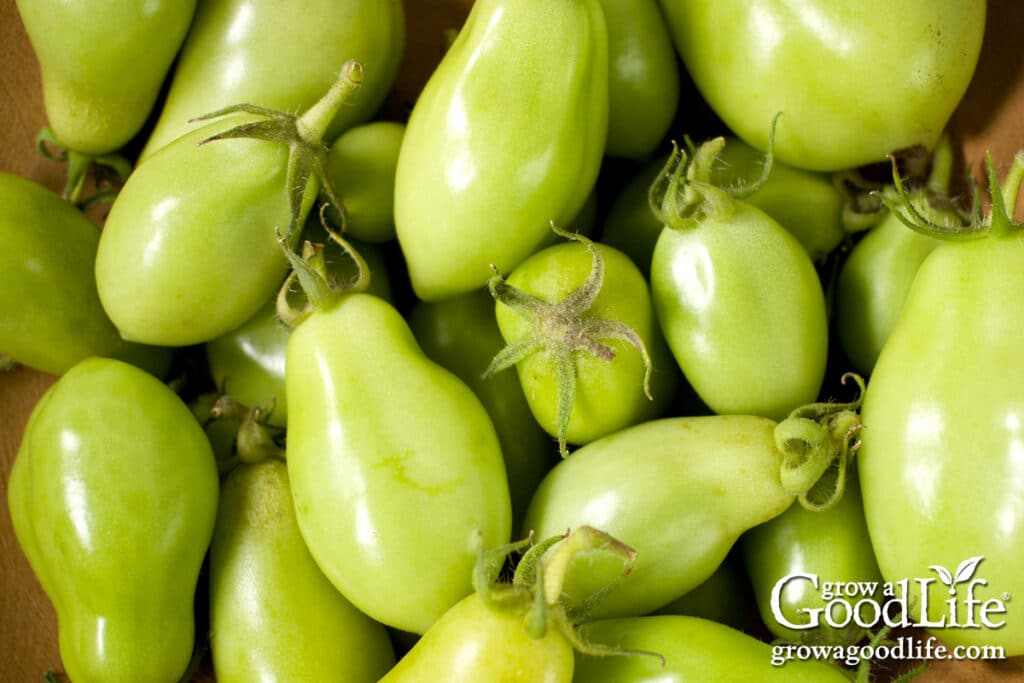
Monitoring Ripeness
Whichever method you choose, it’s important to check your tomatoes regularly. Turn them every few days to promote even ripening, and remove any that show signs of rot or mold to protect the rest. Fully ripe tomatoes should be used immediately for the best flavor and texture.
Ways to Preserve Green Tomatoes
If you’d rather preserve your green tomatoes for later use, freezing, dehydrating, and canning are excellent options. These methods allow you to store your tomatoes for months, ready to be used in soups, sauces, and other recipes.
Freezing Green Tomatoes
Freezing green tomatoes is an easy way to preserve them for future use, especially in cooked dishes like stews, casseroles, or sauces. Follow these steps to prepare and freeze your green tomatoes:
- Prepare the Tomatoes for Freezing: Begin by thoroughly washing your green tomatoes to remove any dirt or debris. Depending on how you plan to use them later, you can freeze them whole, sliced, or chopped. For most recipes, slicing or chopping is recommended for easy use later on.
- Package and Freeze: Spread the tomato slices or chunks on a baking sheet in a single layer to freeze individually. Place the tray in the freezer for a few hours, or until the tomatoes are solid. Once frozen, transfer the tomatoes to airtight freezer bags or containers, removing as much air as possible to prevent freezer burn. Label, date, and store in the freezer.
Frozen green tomatoes can last for up to 12 months in the freezer. They’re best used in cooked dishes, as freezing may change the texture, making them less ideal for fresh use.
Ways to Use Frozen Green Tomatoes:
- Green Tomato Stews and Soups: Frozen green tomatoes are perfect for hearty stews and soups. Their firm texture holds up well when cooked, making them an excellent addition to dishes like vegetable stew or chili. Simply add them to the pot for a tangy, slightly acidic flavor that balances out rich ingredients.
- Green Tomato Sauces: Frozen green tomatoes can be used to make a variety of sauces, from tangy pasta sauce to barbecue sauce. Just thaw, chop, and simmer the tomatoes with onions, garlic, and your favorite spices. You can blend the sauce to your desired consistency and use it on everything from pasta to grilled meats.
- Green Tomato Salsa: Even after freezing, green tomatoes retain their tangy, fresh flavor, which makes them ideal for salsa. Thaw the tomatoes, chop them finely, and mix them with onions, cilantro, lime juice, and jalapeños for a refreshing salsa verde. Serve with tortilla chips or as a topping for tacos and burritos.
- Green Tomato Casseroles: Thawed green tomatoes work well in casseroles. Layer them with other vegetables, cheese, and breadcrumbs for a savory baked dish. Their slight tartness pairs nicely with creamy sauces or sharp cheeses, making for a comforting meal.
- Fried Green Tomatoes: While freezing might alter the texture slightly, you can still use them for fried green tomatoes. Simply thaw, dredge them in seasoned flour, dip in egg, then coat them in cornmeal and breadcrumb coating, and fry them up for a crispy, golden treat. Serve as a side dish or a fun appetizer.
Dehydrating Green Tomatoes
Dehydrating green tomatoes is another excellent way to preserve them, and it’s perfect for making crispy tomato chips, adding to soups, or rehydrating for future recipes.
Just like dehydrating red tomatoes, you can dry green tomatoes using the sun, food dehydrator, or oven. Follow these steps to dehydrate your green tomatoes:
- Prepare the Tomatoes for Drying: Wash the green tomatoes and slice them into even rounds. Uniform slices ensure even drying, and thinner slices will dry more quickly. You can add seasonings like salt, pepper, or herbs to make tomato chips.
- Drying with a Food Dehydrator: Preheat the dehydrator to 135°F. Arrange the prepared tomatoes in a single layer on the dehydrator trays, making sure they don’t overlap. Dry the tomatoes for 8 to 12 hours, or until they are crisp and leathery. The exact drying time will vary based on the thickness and moisture content.
- Drying in an Oven: You can use an oven if you don’t have a food dehydrator. Set the temperature to the lowest setting, around 140 to 170°F. Line a baking sheet with parchment paper and arrange the tomato slices in a single layer. Prop the oven door slightly open to allow moisture to escape. Check the tomatoes every few hours until they are fully dried, which could take 6 to 12 hours.
- Storage Tips: Once fully dried, allow the tomatoes to cool completely. Store them in an airtight jar or vacuum-sealed bags in a cool, dry place. Dehydrated tomatoes can last up to a year if stored properly. You can rehydrate them by soaking them in water or add them directly to soups and stews.
Ways to Use Dehydrated Green Tomatoes:
- Add to Chili, Soups, or Stews: Dehydrated green tomatoes can be rehydrated directly in soups and stews, making them a great addition to brothy or tomato-based dishes. As they simmer, the tomatoes absorb the liquid and plump up, adding a tangy flavor. Use them in soups, stews, or slow-cooker chili.
- Green Tomato Powder: After dehydrating, you can grind the dried green tomatoes into a powder using a food processor or spice grinder. Green tomato powder adds a zesty, tangy punch to soups, sauces, salad dressings, or even as a seasoning for meat and roasted vegetables. Store the powder in an airtight container and use it to boost the flavor of various dishes.
- Green Tomato Chips: Enjoy your dehydrated green tomatoes as chips for a crispy snack. You can season them with salt, pepper, or herbs before dehydrating them to make a savory snack perfect for dipping or enjoying on its own. These crunchy chips can also be crumbled over salads or soups for added texture.
Home Canning Green Tomatoes
Green tomatoes are versatile and can be safely preserved through canning when following tested recipes. Unripe green tomatoes can be substituted for ripe tomatoes in any safe canning recipe. Just follow the same directions, including adding the necessary acid (such as lemon juice or vinegar) to ensure the proper pH level for safe preservation.
However, it’s important to note that tomatoes from frost-killed vines should never be canned. Once frost hits, the pH of the tomatoes changes, and they may no longer be safe for home canning.
Whether you enjoy the tangy pickles, a flavorful relish, or a spicy salsa, there are numerous ways to preserve your green tomatoes for later use. Below are some safe canning recipes divided into categories to help you make the most of your harvest:
Pickled Green Tomatoes
Pickling is one of the simplest and most popular methods for preserving green tomatoes. The vinegar-based brine adds a tangy kick, which you can customize with spices to suit your taste. Pickled green tomatoes can be enjoyed as a snack, added to burgers and sandwiches, or served alongside cheese and charcuterie boards.
- Dill Pickled Green Tomatoes
- Pickled Green Tomato Hot Pepper Mix
- Spiced Pickled Green Tomatoes
- Pickled Sweet Green Tomatoes
- Kosher Style Dill Green Tomato Pickles
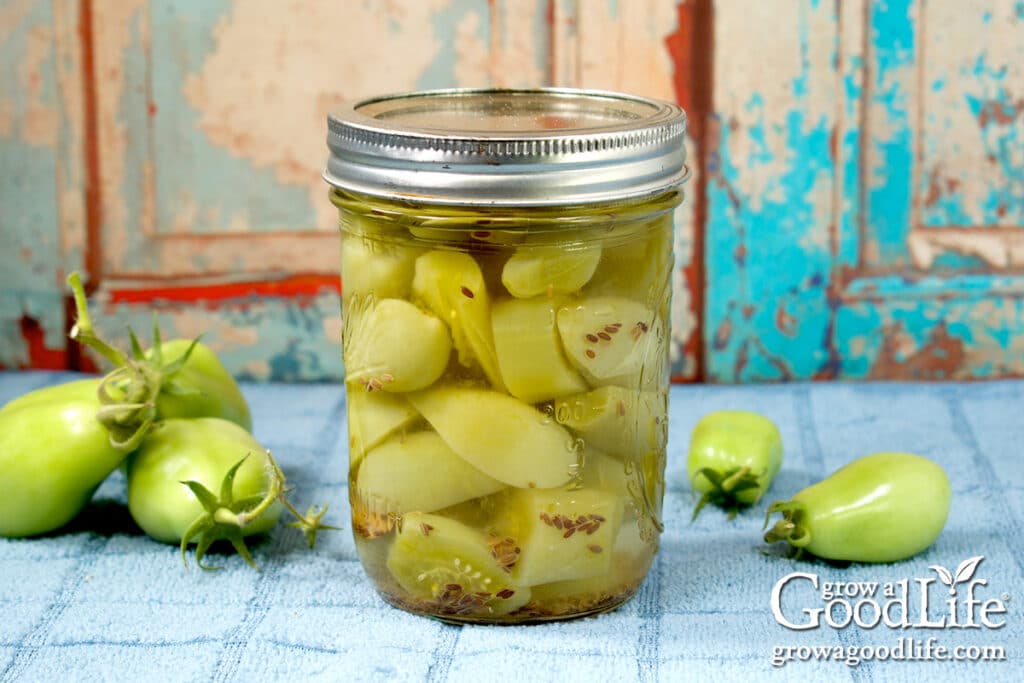
Green Tomato Relish
Relishes made from green tomatoes offer a delightful combination of tart and savory flavors. These condiments are great for adding an extra burst of flavor to sandwiches, hot dogs, and grilled meats. By following safe recipes, you can create vibrant relishes that capture the flavors of your fall garden.
- New England Piccalilli Relish
- Green Tomato Hot Dog Relish
- Pickled Green Tomato Relish
- Rummage Relish
- Fall Garden Relish
- Piccalilli
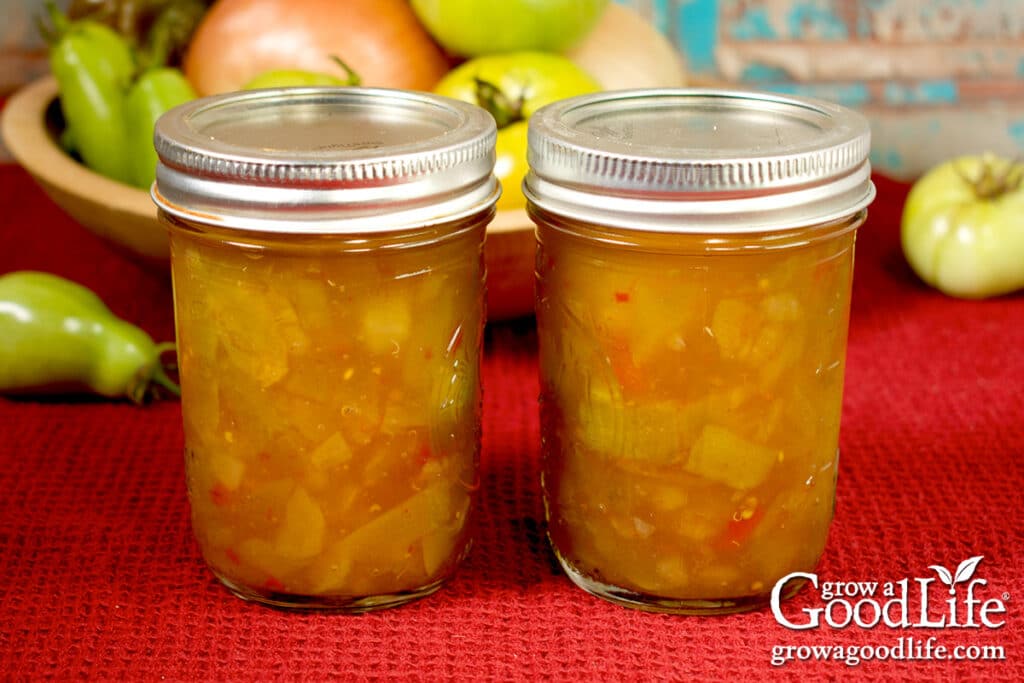
Green Tomato Salsas, Sauces, and Chutneys
For a bold and spicy take on green tomatoes, try canning them in salsas, sauces, or chutneys. These recipes capture the tartness of green tomatoes while infusing them with complementary spices and ingredients. Whether you prefer a zesty salsa verde or a savory chutney, these versatile recipes can be used as condiments, toppings, or meal enhancers.
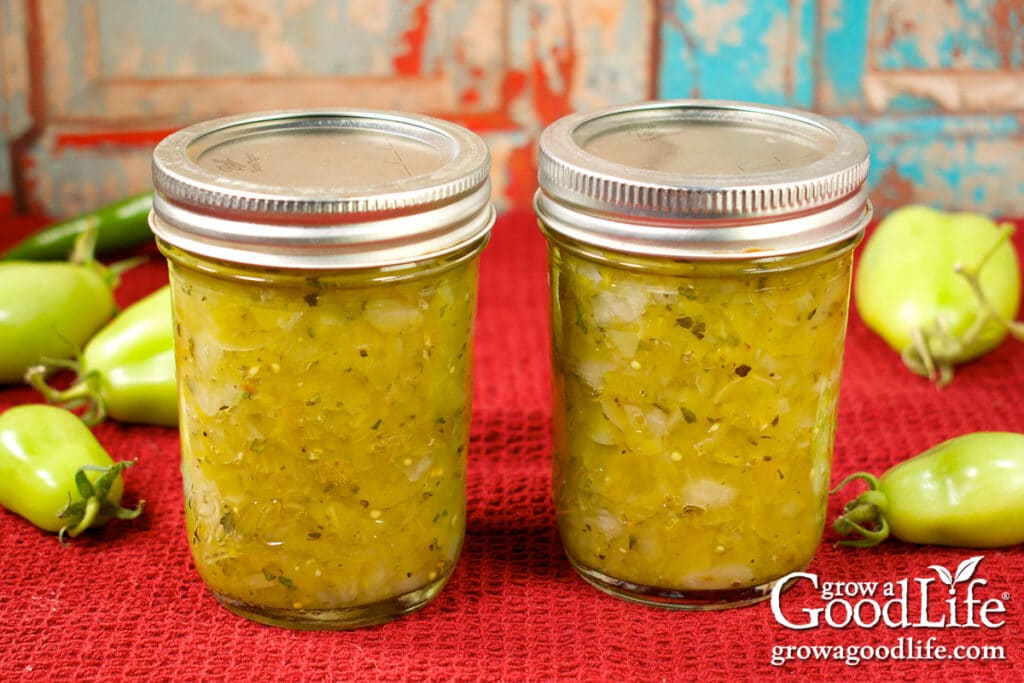
Additional Canning Recipes
Beyond pickles, relishes, and salsas, green tomatoes can be preserved in various ways, including slicing for frying or using them as a unique ingredient in pie fillings. These creative recipes allow you to enjoy the bounty of your garden long after the harvest.
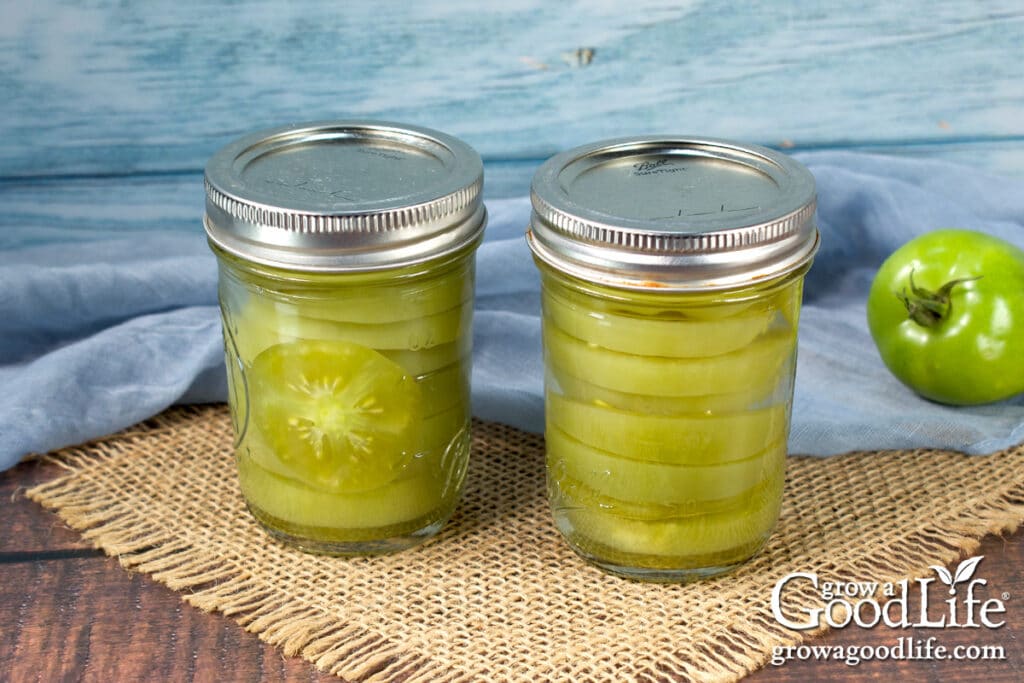
By using these safe, tested recipes, you can enjoy the flavor of your green tomatoes throughout the year. Whether pickled, turned into relish, or added to sauces, green tomatoes are a versatile ingredient that adapts well to preservation.
As the growing season comes to an end, don’t let those unripe tomatoes go to waste. Whether you choose to ripen them indoors, preserve them by freezing or dehydrating, or home caning them for future use, green tomatoes are a versatile ingredient that can be enjoyed in a wide variety of dishes.
If you decide to preserve your green tomatoes, remember that freezing is a quick and easy option that keeps the tomatoes ready for soups, stews, casseroles, and even salsa. Dehydrating lets you make tomato chips, flavorful powders, or rehydrated additions to your favorite chilis and stews. For long-term storage, canning green tomatoes provides endless possibilities, from tangy salsa verde to pickles and relishes that will add a burst of flavor to your winter meals.
Whatever method you choose, I hope these tips and recipes will ensure that your green tomatoes won’t go to waste and can be enjoyed long after the garden season has ended.
You May Also Like:
If you love salsa, consider adding our eBook, Grow a Good Life Guide to 50 Salsa Canning Recipes, to your resource library. This 72-page eBook is packed with a variety of delicious salsa recipes, including classic tomato salsas to roasted and grilled salsas to tomatillo and delicious fruit blends, all safe for water bath canning. It’s the perfect guide to help you preserve your garden harvests.

